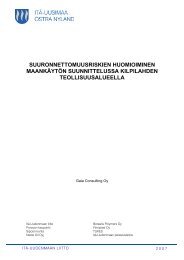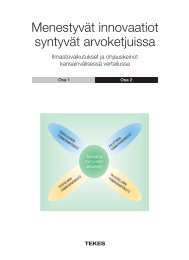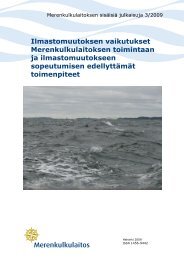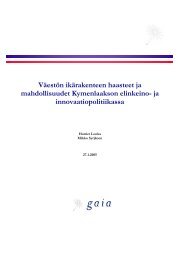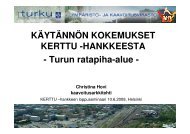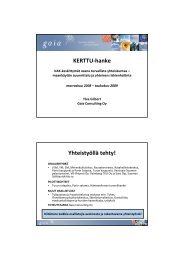227/08 Social challanges s the basis for foresight - Gaia
227/08 Social challanges s the basis for foresight - Gaia
227/08 Social challanges s the basis for foresight - Gaia
You also want an ePaper? Increase the reach of your titles
YUMPU automatically turns print PDFs into web optimized ePapers that Google loves.
Increased costs of energy and materials and<br />
climate change were named as <strong>the</strong> major<br />
trends that will greatly affect <strong>the</strong> societies in<br />
<strong>the</strong> future. Also aging was recognized as one<br />
of <strong>the</strong> major drivers that will create <strong>the</strong> opportunities<br />
<strong>for</strong> Finland.<br />
Major issues identified as <strong>the</strong> most important<br />
cross-cutting topics can be grouped under <strong>the</strong> following<br />
titles and <strong>the</strong>mes. These <strong>the</strong>mes and <strong>the</strong>se<br />
conclusions were produced through few separate<br />
discussion steps.<br />
1. Smart and sustainable living<br />
environments<br />
Finnish building infrastructure will face a large<br />
renovation and re-building boom as <strong>the</strong> building<br />
generation from <strong>the</strong> first urbanization period after<br />
WWII is getting old. At <strong>the</strong> same time <strong>the</strong>re is a<br />
need <strong>for</strong> housing suitable <strong>for</strong> aging population.<br />
This situation creates a great opportunity to build<br />
living concepts that take into account both needs<br />
of aging people as well as <strong>the</strong> energy and material<br />
efficiency. The export opportunities <strong>for</strong> <strong>the</strong>se solutions<br />
are also very good. The participants particularly<br />
emphasized <strong>the</strong> role of increasing Russian<br />
markets. Finnish building cluster is taking a<br />
step ahead to use this opportunity, but it will be a<br />
challenge. The specific issues discussed under<br />
this topic were <strong>the</strong> following.<br />
Flexibility and adaptability are <strong>the</strong> main characteristics<br />
of future buildings and environments.<br />
Aim is to increase <strong>the</strong> life cycle of<br />
buildings.<br />
Home ICT is at <strong>the</strong> edge of big changes. Monitoring<br />
and continuous network connections<br />
open up new opportunities (easy communication<br />
with personal networks from your home,<br />
net communities <strong>for</strong> social interaction from<br />
home, increased interaction with <strong>the</strong> surrounding<br />
environment through monitoring)<br />
Home entertainment solutions emphasizing<br />
physical exercise may gain momentum.<br />
“Functional Games” boom may emerge soon.<br />
Smart home solutions – monitoring and automation<br />
enable new energy and resource man-<br />
agement solutions. The solutions may bring<br />
<strong>the</strong> in<strong>for</strong>mation visible and easily accessible<br />
(consumers have a strong control over <strong>the</strong><br />
management and see effects of <strong>the</strong>ir actions)<br />
and/or intelligent agents take care of optimization.<br />
Home is only one module of <strong>the</strong> living environment.<br />
Decisions and changes in spatial planning<br />
as a whole will be a major issue.<br />
2. Mobility<br />
Generally <strong>the</strong> participants shared a view that <strong>the</strong><br />
mobility of people will decrease in <strong>the</strong> future. The<br />
main driver <strong>for</strong> this argument is <strong>the</strong> increased price<br />
of energy and costs of mobility. The ICT solutions<br />
also enable <strong>the</strong> communication and completion of<br />
different functions through o<strong>the</strong>r means than by<br />
face-to-face meetings. However, it was also<br />
stressed that <strong>the</strong>re is great uncertainty of <strong>the</strong> connection<br />
between ICT and mobility. The research<br />
results are in contradiction whe<strong>the</strong>r ICT and increased<br />
use media technologies are going to increase<br />
or decrease mobility. Mobility is also one of<br />
<strong>the</strong> key <strong>the</strong>mes <strong>for</strong> aging society. Some of <strong>the</strong> activities<br />
and functions can be covered by ICT solutions<br />
but not all. The capability of <strong>the</strong> aging population<br />
to move <strong>the</strong>mselves is one <strong>the</strong> key issues.<br />
General issues discussed were <strong>the</strong> following.<br />
Changing time use patterns and <strong>the</strong> ways how<br />
people will organize <strong>the</strong>ir work and leisure<br />
time will affect a lot this issue. Division of activities<br />
to “staying in on place” and “being on<br />
<strong>the</strong> move” will become on one hand more important<br />
and on <strong>the</strong> o<strong>the</strong>r hand this division will<br />
get blurred. Net presence will become a normal<br />
way of interaction.<br />
If people move around less, <strong>the</strong> “village” societies<br />
will get stronger. Net will provide an important<br />
“window to outside world” and will be<br />
very important part of normal life. There will<br />
be more net communities having an important<br />
role.<br />
No-car-societies will emerge. Mobility <strong>the</strong>me<br />
is strongly linked with smart living concept<br />
and spatial urban planning.<br />
85



